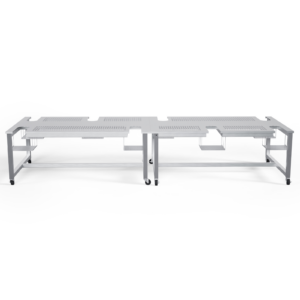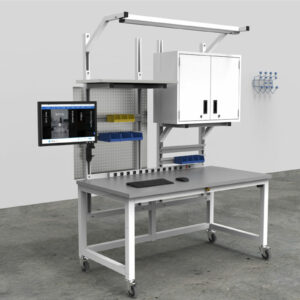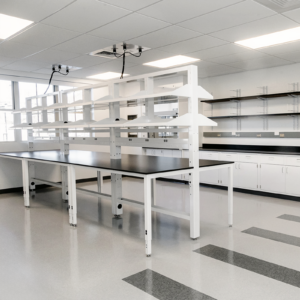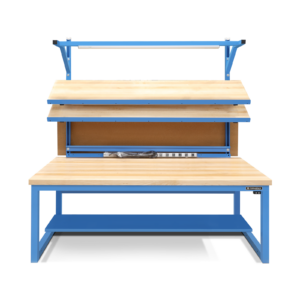Hydraulic fracturing, more commonly known as fracking, has transformed the US energy market by dramatically increasing our supply of oil and natural gas hydrocarbons. We take a look at the current state of the market and the challenges facing upstream and midstream energy companies. We also investigate some of the ways Formaspace’s laboratory furniture applications can support leading oilfield service companies, such as Schlumberger and National Oilwell Varco.

October 1973 was a wake-up call for the American public.
The US economy had become increasingly dependent upon imported oil (to the tune of 6.2 million barrels of oil per day), so when members of the Organization of Arab Petroleum Exporting Countries (OPEC) declared an oil embargo, it hit hard. The bottom fell out of the US stock market. Oil prices quadrupled globally. And, across America, cars lined up for blocks hoping to fill up at the few filling stations that had gasoline on hand.
While the 1973 embargo was lifted in March 1974, a second oil crisis took place again not five years later, as a result of the 1979 Iranian Revolution. Iranian oil production fell significantly, leading to a worldwide supply shortage, which in turn, caused oil prices to skyrocket. Once again, American motorists lined up for blocks at gas stations, hoping to fill up their vehicles at any price.
In response, the US government enacted policies to conserve energy (such as the national 55 mph speed limit), to support research into alternative energy sources, and to encourage domestic oil production.
Remarkable Reversal of Fortune: The USA is on Track to Become a Net Exporter of Oil and Gas
The results have been dramatic. Consider these six key changes in domestic oil and gas production since the 1970s oil crises:
1. The USA Became the World’s Top Producer of Petroleum and Natural Gas Hydrocarbons in 2013.

Since 2008, domestic petroleum and natural gas production have surged 60%. The USA became the top producer of petroleum hydrocarbons in 2013 (surpassing Saudi Arabia) and the top producer of natural gas in 2009 (surpassing Russia).
2. The USA Pumped More Than 10 Million Barrels of Oil During November 2017, Exceeding the Previous Monthly Peak Production Record Set in 1973.

Domestic oil production peaked in 1973 and had been expected to decline for the foreseeable future. However, this past November 2017, US monthly crude oil production exceeded 10 million barrels per day, breaking the 1973 record.
3. In 2017, China Replaced the USA as the World’s Top Oil Importer.

Thanks to increased US domestic oil production, the amount of oil imported by the US is trending downward. We’re still a net importer of oil — to the tune of 7.9 million barrels of oil per day — but no longer the world’s biggest oil importer. That title now goes to China, which imported 8.4 million barrels per day in 2017.
4. Texas is Expected to be #3 in Worldwide Oil Production, After #1 Russia and #2 Saudi Arabia.
According to reports by energy researchers, Texas, with its Permian Basin and Eagle Ford shale oil fields, is expected to become the world’s #3 oil producer, behind only Russia and Saudi Arabia.
5. Oil Reserves in the Permian Basin Located in Texas and New Mexico may Exceed Those of Saudi Arabia’s Ghawar Field
Some oil executives estimate that the amount of petroleum and natural gas hydrocarbons found in the Permian Basin that lies under Western Texas and Eastern New Mexico may exceed that of the reserves held in Saudi Arabia’s Ghawar Field, which is considered the world’s largest conventional oil field.
6. Depending on Future Oil Prices, the USA Could Soon Become a Net Energy Exporter as Soon as 2020

Finally, the question that is on the mind of many of us: when will the USA become fully energy independent? According to the Annual Energy Outlook 2018 report produced for the U.S. Energy Information Administration (EIA), the US could become a net energy exporter as soon as 2020. According to the analysts, the timing is highly dependent upon energy prices; higher worldwide oil and natural gas prices will hasten the shift toward domestic energy independence.
What’s Behind the US Oil and Natural Gas Production Miracle? Hydraulic Fracturing or ‘Fracking’

So what is the underlying reason for this remarkable reversal of fortune that has put the USA back on track to become a net exporter of oil and gas?
The answer can be found in the domestic crude oil production chart above. Domestic exploration and production (E&P) companies in the upstream energy market have been able to unlock “tight” oil and gas formations that conventional drilling methods could not extract.

Known by terms such as “tight oil,” “tight gas,” “shale oil,” and “shale gas,” these hydrocarbon deposits are locked inside geological rock formations, such as the Bakken field in North Dakota, and the Permian Basin and Eagle Ford formations in Texas. To extract them requires “unconventional” drilling technologies, such as hydraulic fracturing (commonly known as “fracking”) to break them free and horizontal (or “directional”) drilling capabilities to bring them to the surface.

In conventional oil and gas exploration and production, wells are typically drilled vertically down into underground pools of hydrocarbons. These types of deposits flow relatively freely, making it possible to extract the hydrocarbons out of the ground fairly easily (and at lower cost)
.However, this approach does not work where hydrocarbons are trapped inside deep-rock formations. Unless some measures are taken, they won’t flow into the well. That’s where hydraulic fracturing, or fracking, comes into the picture.
Fracking operators inject the wellbore with fracking fluid at very high pressures, which is typically a combination of water, chemicals that help dissolve rock formations, as well as sand or other porous “proppants” designed to keep the newly created fractures open so the hydrocarbons can flow out.
While fracking techniques had been tried as early as the 1940s, the American oil pioneer George P. Mitchell is credited with making the fracking process commercially successful in extracting tight oil from shale deposits. His company, Mitchell Energy & Development Corp., invested over $6 million in the 1990s to develop new fracking technologies to unlock shale oil in the Barnett Shale play (”play” being the oil company term for hydrocarbon production area) in North Texas. Success came in 1998, which led to Mitchell’s fracking technique next being implemented in the Bakken oil shale deposits in North Dakota and the Eagle Ford deposits traversing across central Texas.
Challenges Facing Drilling and Oil Services Companies in the Upstream E&P Market

With oil prices well north of the hundred dollars per barrel at the beginning of this decade, fracking operations were able to make money. However, the financial equation suddenly changed in 2014 as oil prices dropped precipitously, falling to a new low in 2016 when Brent crude hit $40 per barrel and West Texas Intermediate (WTI) crude oil $30 per barrel. During the downturn, many producers and oil well service companies were forced to restructure and to reduce their costs. Exploration for new oil and gas fields also took a big hit.
2018 paints a brighter picture for domestic shale oil producers. The boom years have returned to places like the Permian Basin thanks to increasing worldwide oil prices. As of this writing, Brent Crude is now trading at $80 per barrel, while WTI prices are around $72 a barrel — well above the estimated $50 price that most oil companies can profitably operate fracking-based production wells.
Of course, oil producers are keeping an eye on the price of oil, and cost control is still a watchword. Fracking technology is also becoming more efficient, which helps keep production costs under control. New technologies, such as “cube development” and “supersizing,” which increase the number of wells from a single well pad to as many as twenty that fan out in all directions, maximize oil and gas extraction.
In fact, Formaspace has been part of the solution to making operations at oil well services companies more efficient.
For example, we’ve recently created some unique furniture solutions for oil well service company leader Schlumberger. (We’ve also been able to assist our client National Oilwell Varco with Formaspace industrial furniture solutions.) These heavy-duty workstations allow Schlumberger drilling pipes to be reworked back to a good as new condition after they have become damaged during use.
Formaspace also offers a full line of ESD (electrostatic discharge) workstations for manufacturing and reworking equipment with sensitive sensors and other electronic gear that can be damaged by inadvertent static shocks.
Formaspace has a full range of industrial furniture for fracking operations, from mobile lab solutions for use at the wellhead to laboratory furniture designed for fracking chemical laboratories.
Our wet and dry labs can help your chemist and process engineers develop new fracking chemicals. We offer a full line of:
- Modular laboratory furniture
- Sinks and safety showers
- Drying racks
- Biosafety cabinets
- Sample processing lab benches
- Fume Hoods
Formaspace can also provide a full-range of chemically resistant work surfaces to keep your laboratory operating smoothly.
We can also provide efficient and ergonomic solutions for engineering departments. Whether you are designing drills, pumps, or submersible rigs, Formaspace can make your engineering design team facilities a more functional place to work.
Challenges Facing Pipeline and Transportation companies in the Midstream Energy Market
Did you notice how the WTI price of oil in West Texas is significantly lower than the global price of oil?
That’s symptomatic of the problems facing the midstream sector of the energy market (which is responsible for transporting oil and gas). Across the USA, there is a shortage of pipeline capacity to move crude oil and natural gas hydrocarbons from where they are extracted to the downstream energy markets where they are refined or processed (which is typically closer to the end consumers).
For example, it might surprise you that oil is increasingly transported by ship from Texas to the refineries on the US East Coast. The pipeline capacity shortage has also led to increased transportation by rail or by truck.
If you are in the pipeline business, we’d like to introduce you to Formaspace’s line of industrial furniture designed for your pipeline control and monitoring operations.
We can build the right solution for your needs, whether your facilities are mobile-based units or traditional fixed construction.
We provide a full line of monitoring workstations, including height-adjustable desks and ergonomic multi-monitor mounts that will help keep your personnel working at peak production. We can also provide custom-designed storage solutions to keep vital records secure. And all our furniture is made to order, here at our Austin, Texas Factory headquarters.
Turn to Formaspace for Efficient Work Environments in the Upstream Oil and Gas Market
Here at Formaspace, we build custom furniture solutions for the Fortune Global 500 energy companies, Schlumberger and National Oilwell Varco.
If you can imagine it, we can build it.
Try out our free online 3D Visualization tool today — it allows you to design your own custom workbenches in seconds. Once your design is approved, we can take this information directly to our manufacturing facility here at our Austin, Texas headquarters.
Want to know more? Your Formaspace Design Consultant can help. We’re eager to share our wealth of experience in making your industrial facility, laboratory, or engineering design center a more productive and efficient place to work. Make the call today.















